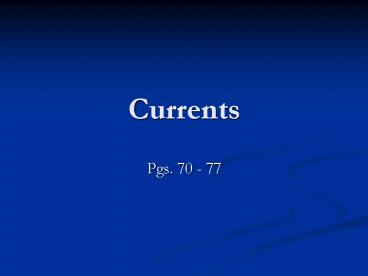Currents - PowerPoint PPT Presentation
1 / 14
Title: Currents
1
Currents
- Pgs. 70 - 77
2
Exploring Currents
- Thor Heyerdahl theorized that the inhabitants
of Polynesia originally sailed from Peru on
rafts powered only by the wind and ocean
currents. - 1947, Heyerdahl sets out to prove his theory by
setting sail from Peru on a man-made raft. - By day 97, Thor and his crew made it to
Polynesia. - Ocean currents sent their raft 6,000km west
across the Pacific ocean. - So if currents carried Thor over the Pacific,
what is driving these currents?
3
Surface Currents
- Streamlike movements of water that occur at or
near the surface of the ocean are called surface
currents. - Currents can be thousands of kilometers in
length. - The Gulf Stream is one of the longer currents
transporting more than 25 times more water than
all the worlds rivers. - What controls these currents?
- Global winds, Coriolis effect, and continental
deflections.
4
Global Winds
- The best way to visualize what global winds do,
is to imagine you are blowing on a cup of hot
chocolate. - The ripples created from you are the same way the
winds blowing across the Earths surface create
surface currents in the ocean. - Surface currents can go down to several hundred
kilometers deep and several thousand kilometers
long. - Certain areas on the world have different
patterns of global winds creating currents in the
oceans.
5
Coriolis Effect
- The Earths rotation causes surface currents to
move in curved paths rather than in straight
lines. - The curving of moving objects from a straight
path due to the Earths rotation is the Coriolis
Effects. - To better understand the coriolis effect, imagine
trying to roll a ball straight across a moving
merry-go-round.
6
Continental Deflections
- If the Earths surface were covered only with
water, the surface currents would travel freely
across the globe in a very uniform pattern. - The continents rise above sea level and when
surface currents meet continents, they deflect,
or change direction. - Think of it like when a bouncy ball hits a wall
and changes direction.
7
Taking Temperatures
- All three, global winds, Coriolis effect, and
continental deflections, work together to form a
pattern of surface currents on Earth. - Warm currents begin near the equator.
- Cold water currents begin near the poles.
- Cold and warm water currents mix and share in all
the oceans.
8
Deep Currents
- Streamlike movements of ocean water far below the
surface are known as a deep current. - Deep currents form in parts of the ocean where
water density increases. - Temperature and salinity combine to affect the
density of ocean water.
9
Deep Current Formation
- At the poles of the Earth, the cold air cools the
water and the cold water sinks down and travels
toward the equator. - If the ocean water freezes, ice will float on top
of water because ice is just water while the
ocean has many dissolved materials in it. - It is denser with more dissolved particles in it.
- Also, in warm, tropical climates, much water is
evaporated, making the water around it more dense
and sink toward the bottom of the ocean.
10
Movement of Deep Currents
- Deep current movement is complex.
- Due to differences in temperature and salinity,
the North Atlantic Deep Water flows on top of the
denser Antarctic Bottom Water. - The Antarctic Bottom Water is so dense that it
takes 750 years for the water to make it to the
equator.
11
Currents Trading Places
- The surface and deep currents exchange places
where they meet. - Warm water from the equator will push cold Arctic
water down to the ocean floor. - The cold water travels the ocean floor until it
meets more cold water from the other pole and
gets force to the surface to warm in temperature
again.
12
Surface Currents and Climate
- Currents affect climate because they bring the
temperature with it. - Warm waters will bring warm weather and cool
waters will bring cool weather. - The Gulf Stream keeps the east coast warm, while
the California current keeps the west coast cool.
13
El Nino
- Surface currents in the tropical region of the
Pacific Ocean usually travel with the trade winds
from east to west. - This causes upwelling in the eastern Pacific
ocean - Upwelling is a process in which cold,
nutrient-rich water from the deep ocean to rise
and replace surface water. - As a result the coastal waters in South America
rise and affects the interactions of global
weather patterns and sea-life.
14
El Nino Effects
- This phenomenon can cause floods, mudslides, and
millions of dollar of damage to areas affected by
it.































